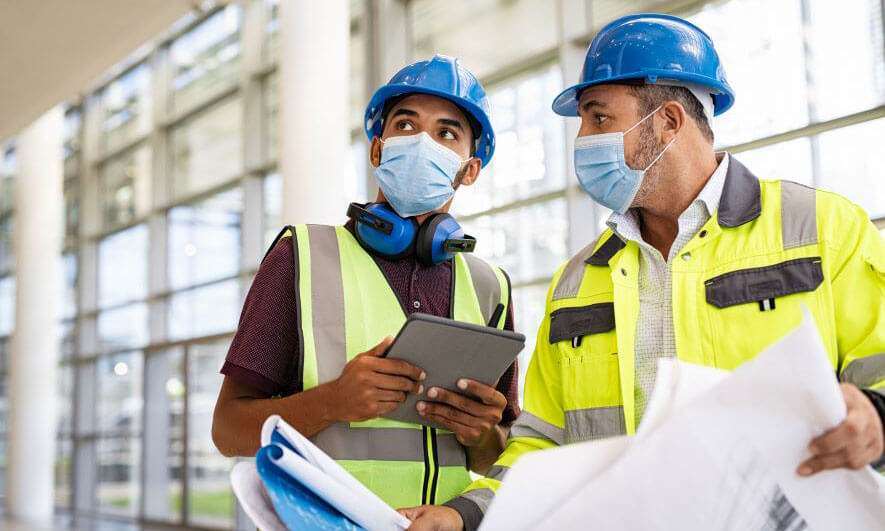
The construction labor shortage continues to be a trend that impacts productivity and worker safety.
Despite the construction unemployment rate being the lowest it has been for nearly three years, the labor shortage remains one of the most important construction industry trends for 2022.
“Labor is and continues to be a very big issue,” said David DeSilva, head of Construction at The Hartford. “There’s a skilled labor shortage that’s hindering the ability to stay within project timelines.”
According to the U.S. Bureau of Labor Statistics, the unemployment rate in the construction industry was 3.5% in July 2022.1 The last time it was lower than this was in September 2019 – about six months before the initial lockdowns from the COVID-19 pandemic started in the U.S.2
According to the U.S. Bureau of Labor Statistics, the unemployment rate in the construction industry was 3.5% in July 2022.1 The last time it was lower than this was in September 2019 – about six months before the initial lockdowns from the COVID-19 pandemic started in the U.S.2
Construction Labor Shortage
The construction labor shortage spiked in 2020 at the height of the COVID-19 pandemic. The unemployment rate spiked to 16.6% in April 2020.3 While it’s improved significantly, finding workers in the industry remains an issue. It’s a problem that existed before the pandemic started, DeSilva said.
“Pre-pandemic labor was already a growing concern. There were more workers leaving the field than entering it. Some firms were addressing it before COVID-19, but I don’t know if they fully solved the issue,” DeSilva explained. “The pandemic really accelerated this shift of workers retiring or changing careers.”
DeSilva added that construction is also an aging workforce where the average worker age continues to increase. This further fuels the need to find workers, particularly younger employees who can gain experience and make a career in construction.
There’s not a simple solution to fix the construction labor shortage, DeSilva emphasized. But it hasn’t stopped companies from finding creative ways to find workers. DeSilva described how some businesses started to recruit veterans or athletes.
“They’re looking at trying to attract folks who are competitive in nature and are used to working hard,” he noted.
How Does the Construction Labor Shortage Impact Construction Companies?
The difficulty with finding workers, especially skilled laborers, affects the construction industry in many ways.
Having less workers means companies have to be more selective in the projects that they can bid on, according to DeSilva.
“Construction companies can’t work on a number of projects at the same time,” he said.
Meeting contract agreements and completing projects on time also becomes harder if companies can’t find workers.
“It’s not just about the fact that there’s less workers, but the efficiency of workers is greatly impacted,” DeSilva explained.
He added that workmanship is also affected by the labor shortage. Workers may rush to finish a project on time or quality may suffer because of an employee’s inexperience.
“Workers who are less tenured or new to construction don’t have the background or experience that’s often needed to complete a job the first time,” DeSilva said. “With less workers in the field, there are higher demands that are put on the workers that are left. This leads to workmanship issues and mistakes.”
The Construction Labor Shortage and Insurance
It’s essential that construction companies regularly review their insurance coverage. DeSilva said the ongoing labor shortage can negatively impact different types of insurance coverage.
“The frequency of claims is certainly on the rise,” DeSilva said. “The construction industry is really feeling the strain from all different areas.”
With workers’ compensation insurance (WC insurance), for example, an aging workforce and younger workers can increase a company’s risk exposure.
“It’s no secret that older workers take longer to recover from an injury. And less experienced workers tend to get injured more often,” DeSilva explained.
He added that The Hartford has seen an uptick in water damage claims in the last three to five years, with many of these attributed to workmanship issues or the labor shortage.
How Are Construction Companies Addressing the Labor Shortage?
As DeSilva noted, the construction industry has been trying to address the labor shortage and its impacts since before the COVID-19 pandemic. He said he’s seen an increase in smart technology use within the industry as a way to improve productivity and worker safety.
“There’s more implementation of onsite imagery, water sensors, wearables on the workers or telematics in fleet vehicles,” he said. “These technological devices are going to drive down loss costs and benefit the companies and workers.”
The investments seem to have a positive impact. The incident rate of nonfatal occupational injuries and illnesses in the construction industry was 2.5 per 100 full-time employee.4 This is lower than the rate in 2019, 2018 and 2017, which were 2.8, 3.0 and 3.1, respectively.
In order to improve worker safety, it has to be a business imperative. Companies need a safety and training program to make sure employees can do their jobs correctly.
“It comes down to accountability,” DeSilva explained. “A lot of the things construction companies are doing when it comes to safety may have been an afterthought six to eight years ago.”
Construction businesses can also invest in measures to help them run an efficient and safe workplace, like partnering with an experienced insurer. DeSilva highlighted The Hartford’s Risk Engineering team as a valuable service to the construction industry. Consultants can work with businesses to identify risks and provide recommendations to address them.
“When you’re living it every day, it’s easy to miss things,” DeSilva said. “Our folks offer a new set of eyes and boots on the ground to provide a new perspective.”